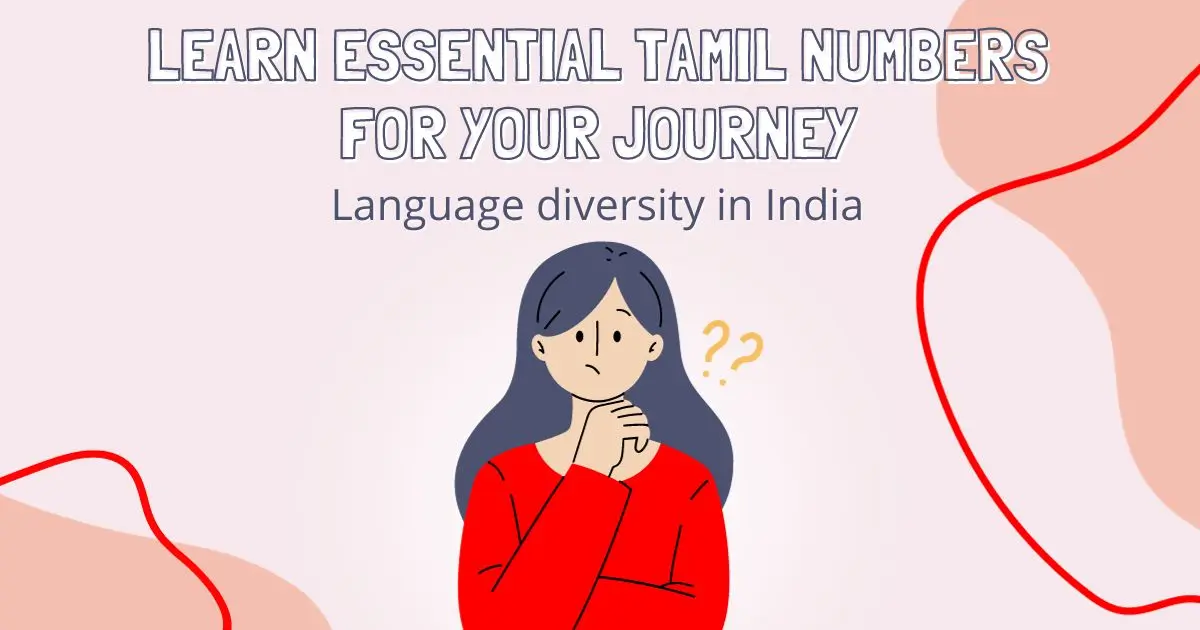Are you planning a visit to the culturally vibrant state of Tamil Nadu? Or perhaps you’re learning Tamil and want to brush up on your numbers? Whatever your reason, mastering the Tamil numbers from 1 to 100 can greatly enhance your experience while shopping, traveling, or simply engaging with locals. These numbers are distinct from Hindi, which is widely spoken in many parts of India, making them invaluable if you find yourself in Tamil Nadu.
While English and Hindi are commonly understood in South India, learning a few Tamil numbers can be a sign of respect for the local culture and help you communicate more effectively. Let’s take a closer look at Tamil numbers from 1 to 100 in English, and don’t forget to watch the accompanying video for pronunciation assistance.
Why Learn Tamil Numbers in Tamil Nadu?
Tamil Nadu, known for its rich culture, history, and stunning landscapes, is a top destination for travelers from around the world. While English and Hindi are commonly understood in South India, learning a few Tamil numbers can be a sign of respect for the local culture and help you communicate more effectively. It can also enhance your travel experience in the following ways:
- Shopping Adventures: When you explore the bustling markets and bazaars of Tamil Nadu, knowing Tamil numbers is essential for haggling and understanding prices. Local vendors often appreciate the effort to communicate in their language.
- Cultural Immersion: Engaging with the locals on a deeper level can be a fulfilling part of your journey. Learning Tamil numbers will enable you to connect with people more easily, fostering memorable interactions.
- Navigating Transportation: Whether you’re negotiating taxi fares or understanding bus schedules, having a grasp of Tamil numbers can make your travel logistics smoother.
- Enhanced Dining Experiences: When you visit local eateries or street food stalls, understanding numbers will help you order and pay with confidence.
Tamil Numbers from 1 to 100
- 1 – Onnu
- 2 – Rendu
- 3 – Moonu
- 4 – Naalu
- 5 – Anju
- 6 – Aaru
- 7 – Yelu
- 8 – Ettu
- 9 – Onbadhu
- 10 – Pathu
Now, as you advance beyond the basic numbers, it’s essential to understand how to form them in Tamil. For instance:
- 11 – Pathi nonnu (Pathu + Onnu)
- 12 – Pannandu (Pathu + Rendu)
- 13 – Pathi monnu (Pathu + Moonu)
- 14 – Pathi naalu (Pathu + Naalu)
- 15 – Pathi nanju (Pathu + Anju)
- 16 – Pathi naaru (Pathu + Aaru)
- 17 – Pathi nelu (Pathu + Yelu)
- 18 – Pathi nettu (Pathu + Ettu)
- 19 – Pathonbathu (Pathu + Onbadhu)
As you reach the twenties, notice how the pattern changes:
- 20 – Irubadhu (Iru + Pathu)
- 21 – Iruvathi onnu (Iruvathu + Onnu)
- 22 – Iruvathi rendu (Iruvathu + Rendu)
- 23 – Iruvathi moonu (Iruvathu + Moonu)
- 24 – Iruvathi naalu (Iruvathu + Naalu)
Continue this pattern up to 100:
- 30 – Mubbathu
- 40 – Naapathu
- 50 – Ambathu
- 60 – Aruvathu
- 70 – Elubathu
- 80 – Enbathu
- 90 – Thonnooru
- 100 – Nooru
All Numbers
Here are all the Tamil numbers from 1 to 100:
- 1 – Onnu
- 2 – Rendu
- 3 – Moonu
- 4 – Naalu
- 5 – Anju
- 6 – Aaru
- 7 – Yelu
- 8 – Ettu
- 9 – Onbadhu
- 10 – Pathu
- 11 – Pathi nonnu (Pathu + Onnu)
- 12 – Pannandu (Pathu + Rendu)
- 13 – Pathi monnu (Pathu + Moonu)
- 14 – Pathi naalu (Pathu + Naalu)
- 15 – Pathi nanju (Pathu + Anju)
- 16 – Pathi naaru (Pathu + Aaru)
- 17 – Pathi nelu (Pathu + Yelu)
- 18 – Pathi nettu (Pathu + Ettu)
- 19 – Pathonbathu (Pathu + Onbadhu)
- 20 – Irubadhu (Iru + Pathu)
- 21 – Iruvathi onnu (Iruvathu + Onnu)
- 22 – Iruvathi rendu (Iruvathu + Rendu)
- 23 – Iruvathi moonu (Iruvathu + Moonu)
- 24 – Iruvathi naalu (Iruvathu + Naalu)
- 25 – Iruvathi anju (Iruvathu + Anju)
- 26 – Iruvathi aaru (Iruvathu + Aaru)
- 27 – Iruvathi yelu (Iruvathu + Yelu)
- 28 – Iruvathi ettu (Iruvathu + Ettu)
- 29 – Iruvathi ombathu (Iruvathu + Onbadhu)
- 30 – Mubbathu
- 31 – Mubbathi onnu (Mubbathu + Onnu)
- 32 – Mubbathi rendu (Mubbathu + Rendu)
- 33 – Mubbathi moonu (Mubbathu + Moonu)
- 34 – Mubbathi naalu (Mubbathu + Naalu)
- 35 – Mubbathi anju (Mubbathu + Anju)
- 36 – Mubbathi aaru (Mubbathu + Aaru)
- 37 – Mubbathi yelu (Mubbathu + Yelu)
- 38 – Mubbathi ettu (Mubbathu + Ettu)
- 39 – Mubbathi ombathu (Mubbathu + Onbadhu)
- 40 – Naapathu
- 41 – Naapathi onnu (Naapathu + Onnu)
- 42 – Naapathi rendu (Naapathu + Rendu)
- 43 – Naapathi moonu (Naapathu + Moonu)
- 44 – Naapathi naalu (Naapathu + Naalu)
- 45 – Naapathi anju (Naapathu + Anju)
- 46 – Naapathi aaru (Naapathu + Aaru)
- 47 – Naapathi yelu (Naapathu + Yelu)
- 48 – Naapathi ettu (Naapathu + Ettu)
- 49 – Naapathi ombathu (Naapathu + Onbadhu)
- 50 – Ambathu
- 51 – Ambath- onnu (Ambathu + Onnu)
- 52 – Ambathi rendu (Ambathu + Rendu)
- 53 – Ambathi moonu (Ambathu + Moonu)
- 54 – Ambathi naalu (Ambathu + Naalu)
- 55 – Ambathi anju (Ambathu + Anju)
- 56 – Ambathi aaru (Ambathu + Aaru)
- 57 – Ambathi yelu (Ambathu + Yelu)
- 58 – Ambathi ettu (Ambathu + Ettu)
- 59 – Ambathi ombathu (Ambathu + Onbadhu)
- 60 – Aruvathu
- 61 – Arubathi onnu (Aruvathu + Onnu)
- 62 – Arubathi rendu (Aruvathu + Rendu)
- 63 – Arubathi moonu (Aruvathu + Moonu)
- 64 – Arubathi naalu (Aruvathu + Naalu)
- 65 – Arubathi anju (Aruvathu + Anju)
- 66 – Arubathi aaru (Aruvathu + Aaru)
- 67 – Arubathi yelu (Aruvathu + Yelu)
- 68 – Arubathi ettu (Aruvathu + Ettu)
- 69 – Arubathi ombathu (Aruvathu + Onbadhu)
- 70 – Elubathu
- 71 – Elubathi onnu (Elubathu + Onnu)
- 72 – Elubathi rendu (Elubathu + Rendu)
- 73 – Elubathi moonu (Elubathu + Moonu)
- 74 – Elubathi naalu (Elubathu + Naalu)
- 75 – Elubathi anju (Elubathu + Anju)
- 76 – Elubathi aaru (Elubathu + Aaru)
- 77 – Elubathi yelu (Elubathu + Yelu)
- 78 – Elubathi ettu (Elubathu + Ettu)
- 79 – Elubathi ombathu (Elubathu + Onbadhu)
- 80 – Enbathu
- 81 – Enbathi onnu (Enbathu + Onnu)
- 82 – Enbathi rendu (Enbathu + Rendu)
- 83 – Enbathi moonu (Enbathu + Moonu)
- 84 – Enbathi naalu (Enbathu + Naalu)
- 85 – Enbathi anju (Enbathu + Anju)
- 86 – Enbathi aaru (Enbathu + Aaru)
- 87 – Enbathi yelu (Enbathu + Yelu)
- 88 – Enbathi ettu (Enbathu + Ettu)
- 89 – Enbathi ombathu (Enbathu + Onbadhu)
- 90 – Thonnooru
- 91 – Thonnuthi onnu (Thonnooru + Onnu)
- 92 – Thonnuthi rendu (Thonnooru + Rendu)
- 93 – Thonnuthi moonu (Thonnooru + Moonu)
- 94 – Thonnuthi naalu (Thonnooru + Naalu)
- 95 – Thonnuthi anju (Thonnooru + Anju)
- 96 – Thonnuthi aaru (Thonnooru + Aaru)
- 97 – Thonnuthi yelu (Thonnooru + Yelu)
- 98 – Thonnuthi ettu (Thonnooru + Ettu)
- 99 – Thonnuthi ombathu (Thonnooru + Onbadhu)
- 100 – Nooru
By familiarizing yourself with these numbers, you’ll be better equipped for your Tamil Nadu journey. Embrace the linguistic diversity of this incredible region, and you’ll find that your travels become even more enriching.
Learning Tamil Numbers: Tips and Pronunciation
Now, let’s delve deeper into the pronunciation of Tamil numbers. To aid in your learning process, here are some tips:
- Listening Practice: Listening to native speakers pronounce these numbers can significantly improve your pronunciation. Be sure to watch the accompanying video for guidance.
- Repetition is Key: Like any language, practice makes perfect. Regularly rehearse the numbers, gradually building your confidence in using them.
- Apps and Language Tools: There are numerous language-learning apps and tools that can assist you in mastering Tamil numbers. These resources often include pronunciation guides and interactive exercises.
Mastering Tamil numbers 1 to 100 is a small yet significant step towards a more immersive and enjoyable experience in Tamil Nadu. Whether you’re bargaining for souvenirs, conversing with locals, or simply navigating the vibrant streets, these numbers will prove invaluable.
So, take the time to practice, and embark on your Tamil Nadu adventure armed with the confidence to connect with the heart and soul of this remarkable state. Happy learning!


